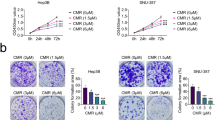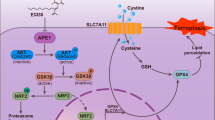Abstract
Hepatocellular carcinoma (HCC) is a primary liver cancer with a high mortality rate that requires research and improved treatment strategies. Chemotherapy is still one of the main methods of HCC treatment, but it may lead to drug resistance and damage to normal organs. Capsaicin, a naturally occurring active ingredient in chili peppers, has demonstrated anticancer properties in a variety of malignant tumor cell lines. However, the anti-cancer mechanism of capsaicin needs to be further explored in HCC. In this study, we utilized Arvanil, a non-stimulating synthetic capsaicin analog, in place of capsaicin. We found that Arvanil induced high mitochondrial calcium flow, which contributed to a decrease in mitochondrial membrane permeability transition pore (mPTP) opening and oxidative phosphorylation levels, ultimately triggering cellular ferroptosis by live cells in real time with a high content screening (HCS) platform and confocal microscopy. It was further confirmed by vina molecular docking and point mutation experiments that Arvanil directly binds to two amino acid sites of mitochondrial calcium uptake protein 1 (MICU1), namely Ser47 and Phe128, to trigger this process, which in turn inhibits the growth of HCC cells. In addition, it was confirmed that Arvanil enhances cisplatin chemosensitivity by inducing HCC cellular ferroptosis in vivo. In conclusion, our study suggests that Arvanil induces ferroptosis in HCC cells and is a candidate drug for the treatment of HCC.
This is a preview of subscription content, access via your institution
Access options
Subscribe to this journal
Receive 12 print issues and online access
$259.00 per year
only $21.58 per issue
Buy this article
- Purchase on Springer Link
- Instant access to full article PDF
Prices may be subject to local taxes which are calculated during checkout






Similar content being viewed by others
Data availability
This study includes no data deposited in external repositories. Structure of MICU1 (PDB: 4xsj) from PDB database: https://www.rcsb.org/structure/4XSJ.Tertiary structure of Arvanil (Compound CID: 6449767) obtained from PubChem: https://pubchem.ncbi.nlmnihgov/# uery=Avanil.
References
Forner A, Reig M, Bruix J. Hepatocellular carcinoma. Lancet. 2018;391:1301–14.
Anwanwan D, Singh K, Singh S, Saikam V, Singh R. Challenges in liver cancer and possible treatment approaches. Biochim Biophys Acta Rev Cancer. 2020;1873:188314.
Llovet M, De Baere T, Kulik L, Haber K, Greten F, Meyer T, et al. Locoregional therapies in the era of molecular and immune treatments for hepatocellular carcinoma. Nat Rev Gastroenterol Hepatol. 2021;18:293–313.
Llovet M, Montal R, Sia D, Finn S. Molecular therapies and precision medicine for hepatocellular carcinoma. Nat Rev Clin Oncol. 2018;15:599–616.
Kastan B, Bartek J. Cell-cycle checkpoints and cancer. Nature. 2004;432:316–23.
Hanahan D, Weinberg RA. Hallmarks of cancer: the next generation. Cell. 2011;144:646–74.
Talmadge E, Fidler J. AACR centennial series: the biology of cancer metastasis: historical perspective. Cancer Res. 2010;70:5649–69.
Clark R, Lee H. Anticancer properties of capsaicin against human cancer. Anticancer Res. 2016;36:837–43.
Chen C, Ko C, Yen C, Chen Y, Lin C, Ma F, et al. Capsaicin enhances erlotinib-induced cytotoxicity via AKT inactivation and excision repair cross-complementary 1 (ERCC1) down-regulation in human lung cancer cells. Toxicol Res. 2019;8:459–70.
Han H, Park K, Nakamura H, Ban S. Capsaicin inhibits HIF-1alpha accumulation through suppression of mitochondrial respiration in lung cancer cells. Biomed Pharmacother. 2022;146:112500.
Hurley D, Akers T, Friedman R, Nolan A, Brown C, Dasgupta P. Non-pungent long chain capsaicin-analogs arvanil and olvanil display better anti-invasive activity than capsaicin in human small cell lung cancers. Cell Adh Migr. 2017;11:80–97.
Dixon J, Lemberg M, Lamprecht R, Skouta R, Zaitsev M, Gleason E, et al. Ferroptosis: an iron-dependent form of nonapoptotic cell death. Cell. 2012;149:1060–72.
Li P, Jiang M, Li K, Li H, Zhou Y, Xiao X, et al. Glutathione peroxidase 4-regulated neutrophil ferroptosis induces systemic autoimmunity. Nat Immunol. 2021;22:1107–17.
Vasan K, Werner M, Chandel S. Mitochondrial metabolism as a target for cancer therapy. Cell Metabol. 2020;32:341–52.
Zhao L, Tang M, Bode M, Liao W, Cao Y. ANTs and cancer: emerging pathogenesis, mechanisms, and perspectives. Biochim Biophys Acta. 2021;1875:188485.
Bonora M, Giorgi C, Pinton P. Molecular mechanisms and consequences of mitochondrial permeability transition. Nat Rev. Mol Cell Biol. 2022;23:266–85.
Zhao L, Deng X, Li Y, Hu J, Xie L, Shi F, et al. Conformational change of adenine nucleotide translocase-1 mediates cisplatin resistance induced by EBV-LMP1. EMBO Mol Med. 2021;13:e14072.
Morciano G, Naumova N, Koprowski P, Valente S, Sardão VA, Potes Y, et al. The mitochondrial permeability transition pore: an evolving concept critical for cell life and death. Biol Rev Camb Philos Soc. 2021;96:2489–521.
Garbincius F, Elrod W. Mitochondrial calcium exchange in physiology and disease. Physiol Rev. 2022;102:893–992.
Gao Y, Hou R, Fei Q, Fang L, Han Y, Cai R, et al. The Three-Herb Formula Shuang-Huang-Lian stabilizes mast cells through activation of mitochondrial calcium uniporter. Sci Rep. 2017;7:38736.
Bermont F, Hermant A, Benninga R, Chabert C, Jacot G, Santo-Domingo J, et al. Targeting mitochondrial calcium uptake with the natural flavonol kaempferol, to promote metabolism/secretion coupling in pancreatic β-cells. Nutrients. 2020;12:538.
Lee S, Kang S, Lee S, Nicolova S, Kim A. Involvement of NADPH oxidase-mediated generation of reactive oxygen species in the apototic cell death by capsaicin in HepG2 human hepatoma cells. Free Radic Res. 2004;38:405–12.
Vendrely V, Peuchant E, Buscail E, Moranvillier I, Rousseau B, Bedel A, et al. Resveratrol and capsaicin used together as food complements reduce tumor growth and rescue full efficiency of low dose gemcitabine in a pancreatic cancer model. Cancer Lett. 2017;390:91–102.
Vendrely V, Amintas S, Noel C, Moranvillier I, Lamrissi I, Rousseau B, et al. Combination treatment of resveratrol and capsaicin radiosensitizes pancreatic tumor cells by unbalancing DNA repair response to radiotherapy towards cell death. Cancer Lett. 2019;451:1–10.
Thoennissen H, O’Kelly J, Lu D, Iwanski B, La T, Abbassi S, et al. Capsaicin causes cell-cycle arrest and apoptosis in ER-positive and -negative breast cancer cells by modulating the EGFR/HER-2 pathway. Oncogene. 2010;29:285–96.
Lv L, Zhuang X, Zhang W, Tian N, Dang Z, Wu Y. Capsaicin-loaded folic acid-conjugated lipid nanoparticles for enhanced therapeutic efficacy in ovarian cancers. Biomed Pharmacother. 2017;91:999–1005.
Liu Y, Wei G, Li S. Capsaicin induces ferroptosis of NSCLC by regulating SLC7A11/GPX4 signaling in vitro. Sci Rep. 2022;12:11996.
Huang P, Chen C, Wu C, Chen T, Tang Y, Ho T, et al. Capsaicin-induced apoptosis in human hepatoma HepG2 cells. Anticancer Res. 2009;29:165–74.
Funding
This study was funded by the National Natural Science Foundation of China (No.82103653), the China Postdoctoral Science Foundation (No.2021M693553), the Natural Science Foundation of Hunan Province (No.2022JJ40659 and No.2022JJ40686).
Author information
Authors and Affiliations
Contributions
Supervision: LL and XD; study concept and design: LZ and LL; drafting of the manuscript: LZ, XD, NL and YG; collection, analysis, or interpretation of data: LZ, YG, NL and XD; technical or material support: LZ and XD.
Corresponding author
Ethics declarations
Competing interests
The authors declare no competing interests.
Additional information
Publisher’s note Springer Nature remains neutral with regard to jurisdictional claims in published maps and institutional affiliations.
Supplementary information
Rights and permissions
Springer Nature or its licensor (e.g. a society or other partner) holds exclusive rights to this article under a publishing agreement with the author(s) or other rightsholder(s); author self-archiving of the accepted manuscript version of this article is solely governed by the terms of such publishing agreement and applicable law.
About this article
Cite this article
Deng, X., Gui, Y., Zhao, L. et al. Arvanil induces ferroptosis of hepatocellular carcinoma by binding to MICU1. Cancer Gene Ther 31, 148–157 (2024). https://doi.org/10.1038/s41417-023-00690-3
Received:
Revised:
Accepted:
Published:
Issue Date:
DOI: https://doi.org/10.1038/s41417-023-00690-3



